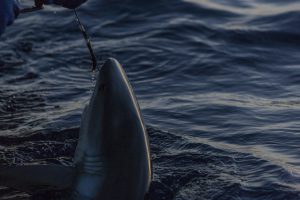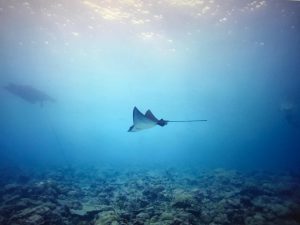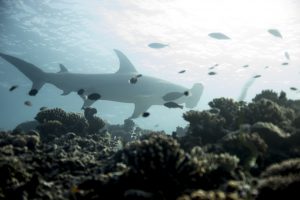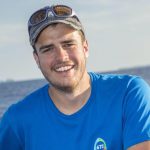The Importance of the Chagos Archipelago for Pelagic Predators in the Indian Ocean
Project Overview
Apex predators are crucial as regulators of our oceans and indicators of a healthy ecosystem. Top predators such as tunas and sharks, most of which are threatened with extinction, are under increasing pressure from fisheries, energy extraction and climate change. Moreover, we have a very limited understanding of their population ecology which in turn hinders our ability to manage them effectively.
Recently, MPAs have been increasing both in number and size but only a few empirical studies have investigated their effectiveness and use for protecting its highly mobile pelagic predators. To address this question, we are running a three-year research interdisciplinary programme combining biologging, chemical tracer analysis (stable isotopes and genomics), applied fisheries science and oceanography. We hope the collected data will allow us to better understand where and when such pelagic predators aggregate within Chagos, how connected the Chagos Archipelago’s community is with the wider Indian Ocean and how efficient is its MPA as a management strategy for pelagic predators of the Indian Ocean.
Our belief is that this endeavor will help understand the role of the Chagos Archipelago MPA plays in the ecology of pelagic predators within the Indian Ocean and shed light on its potential to conserve these crucial species.
Yellowfin tuna is classified as 'Overfished and Subject to Overfishing' in the Indian Ocean by the Indian Ocean Tuna Commission. We need urgent action to stabilise its population.
Key Facts



Publications

Environmental Stress Reduces Shark Residency to Coral Reefs
Williamson, M., Tebbs, E., Curnick, D., Ferretti, F., Carlisle, A.B., Chapple, T.K., Schallert, R., Tickler, D., Block, B., Jacoby, D. (2024). Environmental stress reduces shark residency to coral reefs. Communications Biology

Pop-up Archival Tags Reveal Environmental Influences on the Vertical Movements of Silvertip Sharks (Carcharhinus albimarginatus)
Tickler, D.M., Carlisle, A.B., Meeuwig, J.J., Chapple, T.K., Curnick, D., Dale, J.J., Castleton, M.J., Schallert, R.J., Block, B.B. (2023). Pop-up archival tags reveal environmental influences on the vertical movements of silvertip sharks (Carcharhinus albimarginatus). Marine Ecological Progress Series.

Environmental DNA Helps Reveal Reef Shark Distribution Across a Remote Archipelago
Dunn, N., Curnick, D.J., Carbone, C., Carlisle, A.B., Chapple, T.K., Dowell, R., Ferretti, F., Jacoby, D.M.P., Schallert, R.J., Steyaert, M., Tickler, D.M., Williamson, M.J., Block, B.A., Savolainen, V. (2023). Environmental DNA helps reveal reef shark distribution across a remote archipelago. Ecological Indicators.

Environmental DNA Reveals the Diversity and Abundance of Sharks and Rays in a Remote Coral Reef Atoll
Dunn, N., Savolainen, V., Weber, S., Andrzejaczek, S., Carbone, C., Curnick, D. (2022). Environmental DNA reveals the diversity and abundance of sharks and rays in a remote coral reef atoll. Molecular Ecology. Zoological Society of the Linnean Society.
Emergent research and priorities for shark and ray conservation.
Jorgensen, S.J., Micheli, F., White, T.D., Van Houtan, K.S., Alfaro-Shigueto, J., Andrzejaczek, S., Arnoldi, N.S., Baum, J.K., Block, B., Britten, G.L., Butner, C., Caballero, S., Cardeñosa, D., Chapple, T.K., Clarke, S., Cortés, E., Dulvy, N.K., Fowler, S., Gallagher, A.J., Gilman, E., Godley, B.J., Graham, R.T., Hammerschlag, N., Harry, A.V., Heithaus, M.R., Hutchinson, M., Huveneers, C., Lowe, C.G., Lucifora, L.O., MacKeracher, T., Mangel, J.C., Martins, A.P.B., McCauley, D.J., McClenachan, L., Mull, C., Natanson, L.J., Pauly, D., Pazmiño, D.A., Pistevos, J.C.A., Queiroz, N., Roff, G., Shea, B.D., Simpfendorfer, C.A., Sims, D.W., Ward-Paige, C., Worm, B., Ferretti, F., (2022) Emergent research and priorities for shark and ray conservation. Endangered Species Research.



















